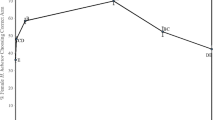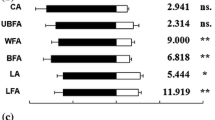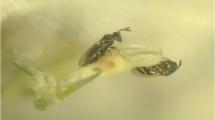Abstract
The response ofMicroplitis croceipes (Cresson) to odors from a plant-host complex was investigated using a four-choice olfactometer. Female, but not male, parasitoids responded in a dose-dependent fashion to volatiles from the plant-host complex and oviposition experience enhanced this response. Female age had no apparent effect on the response. Both artificially damaged leaves and frass elicited positive responses but of lower magnitude than those elicited by the plant-host complex. Volatiles collected from the plant-host complex placed on filter paper also elicited positive responses by female parasitoids.
Similar content being viewed by others
References
Arthur, A.P. 1981. Host acceptance by parasitoids, pp. 97–120,in D.A. Nordlund, R.L. Jones, and W.J. Lewis (eds.). Semiochemicals: Their Role in Insect Control. John Wiley & Sons, New York.
Camors, F.B., andPayne, T.L. 1972. Response ofHeydenia unica (Hymenoptera: Pteromalidae) toDendroctonus frontalis (Coleoptera: Scolytidae) pheromones and a host-tree terpene.Ann. Entomol. Soc. Am. 65:31–33.
Conover, W.J., 1980. Statistical Methods Based on Ranks: Practical Nonparametric Statistics, 2nd Ed. John Wiley & Sons, New York.
Drost, Y.C., Lewis, W.J., Zanen, P.O., andKeller, M.A., 1986. Beneficial arthropod behavior mediated by airborne semiochemicals. I. Flight behavior and influence of preflight handling ofMicroplitis croceipes (Cresson).J. Chem. Ecol. 12:1247–1262.
Elzen, G.W., Williams, H.J., andVinson, S.B. 1984. Isolation and identification of cotton synomones mediating searching behavior by parasitoidCampoletis sonorensis.J. Chem. Ecol. 10:1251–1264.
Gross, H.R., Jr., Lewis, W.J., Jones, R.L., andNordlund, D.A. 1975. Kairomones and their use for management of entomophagous insects: III. Stimulation ofTrichogramma achaeae, T. pretiosum andMicroplitis croceipes with host-seeking stimuli at time of release to improve their efficiency.J. Chem. Ecol. 1:431–438.
Jones, R.L., Lewis, W.J., Bowman, M.C., Beroza, M., andBierl, B.A. 1971. Host-seeking stimulant for a parasite of the corn earworm: Isolation, identification, and synthesis.Science 173:842–843.
Lewis, W.J., Jones, R.L., Gross, H.R., Jr, andNordlund, D.A. 1976. The role of kairomones and other behavioral chemicals in host finding by parasitic insects.Behav. Biol. 16:267–289.
Nordlund, D.A., andLewis, W.J. 1976. Terminology of chemical releasing stimuli in intraspecific and interspecific interactions.J. Chem. Ecol. 2:211–220.
Pettersson, J. 1970. An aphid sex attractant. I. Biological studies.Entomol. Scand. 1:63–73.
Read, D.P., Feeny, P.P., andRoot, R.B. 1970. Habitat selection by the aphid parasiteDiaeretiella rapae (Hymenoptera: Braconidae) and hyperparasiteCharips brassicae (Hymenoptera: Cynipidae).Can. Entomol. 102:1567–1578.
Steel, R.G.D., andTorrie, J.H. 1960. Principles and Procedures of Statistics. McGraw-Hill, New York.
Vet, L.E.M., Van Lenteren, J.C., Heymans, M., andMeelis, E. 1981. An airflow olfactometer for measuring olfactory responses of hymenopterous parasitoids and other small insects.Physiol. Entomol. 8:97–106.
Vinson, S.B. 1976. Host selection by insect parasitoids.Annu. Rev. Entomol. 21:109–133.
Weseloh, R.M. 1981. Host-location by insect parasitoids, pp. 79–95,in D.A. Nordlund, R.L. Jones, and W.J. Lewis (eds.). Semiochemicals: Their Role in Insect Control. John Wiley & Sons, New York.
Author information
Authors and Affiliations
Additional information
Mention of a commercial or proprietary product does not constitute an endorsement by the USDA.
Rights and permissions
About this article
Cite this article
Eller, F.J., Tumlinson, J.H. & Lewis, W.J. Beneficial arthropod behavior mediated by airborne semiochemicals. II. Olfactometric studies of host location by the parasitoidMicroplitis croceipes (Cresson) (Hymenoptera: Braconidae). J Chem Ecol 14, 425–434 (1988). https://doi.org/10.1007/BF01013894
Received:
Accepted:
Issue Date:
DOI: https://doi.org/10.1007/BF01013894




